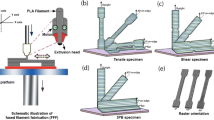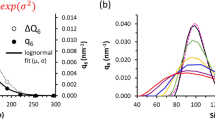Abstract
Understanding soot nanoparticle interaction with oil additives and the causes of soot-induced thickening would assist in lubricant formulation, prolonging engine life and improving engine efficiency. Three-dimensional measurement of soot structures is currently not undertaken as established techniques are limited to two dimensions. While they give valuable information on the structure and reactivity of soot nanoparticles, it is not easy to correlate this to geometry of primary particles and agglomerates. In this work, we investigate the development and application of 3D-TEM for characterisation of soot agglomerates as a new capability to yield information on the volumetric character of fractal nanoparticles. This investigation looks at the feasibility for volume reconstruction of nanometric soot particles in used engine oil from multiple imaging at different tilt angles. Bright-field TEM was used to capture two-dimensional images of soot. Heptane and diethyl ether washes were used to remove volatile contaminants and allowed for images from −60° to +60° tilt with no sign of carbon build-up to be acquired. Tomographic reconstruction from the aligned tilt-series images based on weighted back-projection algorithm has yielded useful information about complex soot nanoparticle size. Estimation of soot mass in oil by nanoparticle tracking analysis (NTA) can be considerably improved by taking into account the three-dimensional shape of the soot agglomerate including the shape factor in the calculations. 3D-TEM measurements were compared with values calculated by using a single-sphere approach when tracking nanoparticles moving under Brownian motion. A shape factor was calculated, dividing the surface area and volume calculated using spherical geometrical estimates, by the respective values calculated using the 3D models. The spherical model of the particle is found on average to overestimate the surface area by sevenfold, and the volume to the actual soot agglomerate by 23 times. Applying the calculated shape factor as a correction reduces the NTA overestimation by one order of magnitude.







Similar content being viewed by others
References
Suhre, B., Foster, D.: In: Cylinder Soot Deposition Rates Due to Thermophoresis in a Direct Injection Diesel Engine. SAE Technical Paper 921629 (1992). doi: 10.4271/921629
Kittelson, D., Ambs, J., Hadjkacem, H.: In: Particulate Emissions from Diesel Engines: Influence of In-Cylinder Surface. SAE Technical Paper 900645 (1990). doi: 10.4271/900645
Esangbedo, C., Boehman, A.L., Perez, J.M.: Characteristics of diesel engine soot that lead to excessive oil thickening. Tribol. Int. 47, 194–203 (2012)
Green, D.A., Lewis, R.: The effects of soot-contaminated engine oil on wear and friction: a review. Proc. Inst. Mech. Eng. Part D J. Automob. Eng. 222(9), 1669–1689 (2008)
Li, S., Csontos, A., Gable, B., Passut, C., et al.: In: Wear in Cummins M-11/EGR Test Engines. SAE Technical Paper 2002-01-1672, (2002). doi: 10.4271/2002-01-1672
Gautama, M., Chitoora, K., Durbhaa, M., Summers, J.C.: Effect of diesel soot contaminated oil on engine wear investigation of novel oil formulations. Tribol. Int. 32, 687–699 (1999)
Achombili, A., La Rocca, A., Shayler, P.J.: In: Investigating the Effect of Carbon Nanoparticles on the Viscosity of Lubricant Oil from Light Duty Automotive Diesel Engines. SAE 2014 World Congress. 2014-04-01 (2014)
Rogak, N.R., Flagan, R.C.: Characterization of the structure of agglomerate particles. Part. Part. Syst. Charact. 9, 19–27 (1992)
Van Poppel, L.H., Friedrich, H., Spinsby, J., Chung, S.H., Seinfield, J.H., Buseck, P.R.: Electron tomography of nanoparticle clusters: implications for atmospheric lifetimes and radiative forcing of soot. Geophys. Res. Pap. (2005). doi:10.1029/2005GL024461
La Rocca, A., Di Liberto, G., Shayler, P., Parmenter, C., et al.: A novel diagnostics tool for measuring soot agglomerates size distribution in used automotive lubricant oils. SAE Int. J. Fuels Lubr. 7(1), 301–306 (2014). doi:10.4271/2014-01-1479
Bardasz, E., Cowling, S., Ebeling, V., George, H. et al.: In: Understanding Soot Mediated Oil Thickening Through Designed Experimentation—Part 1: Mack EM6-287, GM 6.2L. SAE Technical Paper 952527, (1995). doi: 10.4271/952527
Leong, K.C., Murshed, S.M.S., Yang, C.: Investigations of thermal conductivity and viscosity of nanofluids. Int. J. Therm. Sci. 47(5), 560–568 (2008)
Hussein, A.M., Sharma, K.V., Bakar, R.A., Kadirgama, K.: The effect of nanofluid volume concentration on heat transfer and friction factor inside a horizontal tube. J. Nanomater. (2013). doi:10.1155/2013/859563
Chavalier, J., Tillement, O., Ayela, F.: Rheological properties of nanofluids flowing through microchannels. Appl. Phys. Lett. 91, 233103 (2007)
Corcione, M.: Empirical correlating equations for predicting the effective thermal conductivity and dynamic viscosity of nanofluids. Energy Convers. Manag. 52(1), 789–793 (2011)
Tao, R., Xu, X.: Viscosity reduction in liquid suspensions by electric or magnetic fields. Int. J. Mod. Phys. B 19(7&9), 1283–1289 (2005)
Toda, K., Hisamoto, F.: Extension of Einstein’s viscosity equation to that for concentrated dispersions of solutes and particles. J. Biosci. Bioeng. 102(6), 524–528 (2006)
Covitch, M., Humphrey, B., Ripple, D.: In: Oil Thickening in the Mack T-7 Engine Test—Fuel Effects and the Influence of Lubricant Additives on Soot Aggregation. SAE Technical Paper 852126 (1985). doi: 10.4271/852126
Clague, A.D.H., Donnet, J.B., Wang, T.K., Peng, J.C.M.: A comparison of diesel engine soot with carbon black. Carbon 37(10), 1553–1565 (1999)
Enzhu, Hu, Xianguo, Hu, Liu, Tianxia, Fang, Ling, Dearn, Karl D., Hongming, Xu: The role of soot particles in the tribological behavior of engine lubricating oils. Wear 304(1–2), 152–161 (2013)
Lahouij, I., Dassenoy, F., Vacher, B., Sinha, K., Devine, D.A., Brass, M.: Understanding the deformation of soot particles/agglomerates in a dynamic contact: TEM in situ compression and shear experiments. J. Tribol. Lett. 53(1), 91–99 (2014)
La Rocca, A., Di Liberto, G., Shayler, P.J., Fay, M.W., Parmenter, C.D.J.: Application of nanoparticle tracking analysis platform for the measurement of soot-in-oil agglomerates from automotive engines. Tribol. Int. 70, 142–147 (2014)
Saghi, Z., Midgley, P.A.: Electron tomography in the (S)TEM: from nanoscale morphological analysis to 3D atomic imaging. Annu. Rev. Mater. Res. 42, 59–79 (2012)
Saghi, Z., et al.: Three-dimensional morphology of iron oxide nanoparticles with reactive concave surfaces. A compressed sensing-electron tomography (CS-ET) approach. Nano Lett. 11(11), 4666–4673 (2011)
Florea, I., et al.: 3D analysis of the morphology and spatial distribution of nitrogen in nitrogen-doped carbon nanotubes by energy-filtered transmission electron microscopy tomography. J. Am. Chem. Soc. 134(23), 9672–9680 (2012)
De Jonge, N., Sourgat, R., Northan, B.M., Pennycook, S.J.: Three-dimensional scanning transmission electron microscopy of biological specimens. Microsc. Microanal. 16, 54–63 (2010)
Midgley, P.A., Dunin-Borkowski, R.: Electron tomography and holography in materials science. Nat. Mater. 8, 271–280 (2009)
Koster, A.J., Ziese, U., Verkleij, A.J., Janssen, A.H., de Graaf, J., Geus, J.W., de Jong, K.P.: Development and application of 3-dimensional transmission electron microscopy (3D-TEM) for the characterization of metal-zeolite catalyst systems. Stud. Surf. Sci. Catal. 130, 329–334 (2000)
Koster, A.J., Ziese, U., Verkleij, A.J., Janssen, A.H., de Jong, K.P.: Three-dimensional electron microscopy: a novel imaging and characterization technique with nanometer scale resolution for materials science. J. Phys. Chem. B 104, 9368–9370 (2000)
Janssen, A.H., Koster, A.J., de Jong, K.P.: On the shape of the mesopores in zeolite Y: a three dimensional transmission electron microscopic study combined with texture analysis. J. Phys. Chem. B 106, 11905–11909 (2002)
Ziese, U., de Jong, K.P., Koster, A.J.: Electron tomography: a tool for 3D structural probing of heterogeneous catalysts at the nanometer scale. Appl. Catal. A 260(1), 71–77 (2004)
Kaneko, K., Inoke, K., Sato, K., Kitawaki, K., Higashida, H., Arslan, I., Midgley, P.A.: TEM characterization of Ge precipitates in an Al–1.6 at.% Ge alloy. Ultramicroscopy 108(3), 210–220 (2008)
Feng, Z.Q., Yang, Y.Q., Huang, B., Luo, X., Li, M.H., Chen, Y.X., Han, M., Fu, M.S., Ru, J.G.: HRTEM and HAADF-STEM tomography investigation of the heterogeneously formed S(Al2CuMg) precipitates in Al–Cu–Mg alloy. Phil. Mag. 93(15), 1843–1858 (2013)
Li, M.H., Yang, Y.Q., Huang, B., Luo, X., Zhang, W., Han, M., Ru, J.G.: Development of advanced electron tomography in materials science based on TEM and STEM Trans. Nonferrous Met. Soc. China 24, 3031–3050 (2014)
Arslan, I., Tong, J.R., Midgley, P.A.: Reducing the missing wedge: high-resolution dual axis tomography of inorganic materials. Ultramicroscopy 106(11–12), 994–1000 (2006)
Midgley, P.A., Dunin-Borkowski, R.E.: Electron tomography and holography in materials science. Nat. Mater. 8(4), 271–280 (2009)
Biermans, E., Molina, L., Batenburg, K.J., Bals, S., van Tendeloo, G.: Measuring porosity at the nanoscale by quantitative electron tomography. Nano Lett. 10(12), 5014–5019 (2010)
Bals, S., Batenburg, K.J., Verbeeck, J., Sijbers, J., van Tendeloo, G.: Quantitative three-dimensional reconstruction of catalyst particles for bamboo-like carbon nanotubes. Nano Lett. 7(12), 3669–3674 (2007)
Leary, R., Saghi, Z., Midgley, P.A., Holland, D.J.: Compressed sensing electron tomography. Ultramicroscopy 131, 70–91 (2013)
Miao, J.W., Forster, F., Levi, O.: Equally sloped tomography with oversampling reconstruction. Phys. Rev. B 72(5), 052103 (2005)
Lee, E., Fahimian, B.P., Iancu, C.V., Murphy, G.E., Wright, E.R., Castano-Diez, D., Jensen, G.J., Miao, J.W.: Radiation dose reduction and image enhancement in biological imaging through equally-sloped tomography. J. Struct. Biol. 164(2), 221–227 (2008)
La Rocca, A., Bonatesta, F., Fay, M.W., Campanella, F.: Characterisation of soot in oil from a gasoline direct injection engine using transmission electron microscopy. Tribol. Int. 86(June), 77–84 (2015)
Bonatesta, F., Chiappetta, E., La Rocca, A.: Part-load particulate matter from a GDI engine and the connection with combustion characteristics. Appl. Energy 124(1), 366–376 (2014)
Fernandez, J.: Computational methods for electron tomography. Micron 43(10), 1010–1030 (2012)
Radermacher, M.: Weighted back-projection methods. In: Frank, J. (ed.) Electron Tomography, pp. 91–115. Plenum Press, NewYork (1992)
Radermacher, M.: Weighted back-projection methods. In: Frank, J. (ed.) Electron Tomography: Methods for Three-Dimensional Visualisation of Structures in the Cell, 2nd edn, pp. 245–273. Springer, New York (2006)
Fernández, J.J., Agulleiro, J.I., Bilbao-Castro, J.R., Martínez, A., García, I., Chichón, F.J., Martín-Benito, J., Carrascosa, J.L.: Image processing in electron tomography. In: Méndez-Vilas A., Díaz J. (eds.) Microscopy: Science, Technology, Applications and Education, vol. 3. Microscopy series no. 4. Formatex (2010)
Fernandez, J.J.: Computational methods for materials characterization by electron tomography. Curr. Opin. Solid State Mater. Sci. 17(3): 93–106, ISSN 1359-0286, http://dx.doi.org/10.1016/j.cossms.2013.03.002
La Rocca, A., Di Liberto, G., Shayler, P.J., Fay, M.W.: The nanostructure of soot-in-oil particles and agglomerates from an automotive diesel engine. Tribol. Int. 61, 80–87 (2013)
Mastronarde, D.N.: Automated electron microscope tomography using robust prediction of specimen movements. J. Struct. Biol. 152, 36–51 (2005)
Kremer, J.R., Mastronarde, D.N., McIntosh, J.R.: Computer visualization of three-dimensional image data using IMOD. J. Struct. Biol. 116, 71–76 (1996)
Florea, I., et al.: 3D analysis of the morphology and spatial distribution of nitrogen in nitrogen-doped carbon nanotubes by energy-filtered transmission electron microscopy tomography. J. Am. Chem. Soc. 134, 9672–9680 (2012)
Yoshizawa, N., Tanaike, O., Hatori, H., Yoshikawa, K., Kondo, A., Abe, T.: TEM and electron tomography studies of carbon nanospheres for lithium secondary batteries. Carbon 44, 2558–2564 (2006)
Medalia, A.I.: Morphology of aggregates VI. Effective volume of aggregates of carbon black from electron microscopy; application to vehicle absorption and to die swell of filled rubber. J. Colloid Interface Sci. 32(1), 115–131 (1970)
Volkmann, N.: Methods for segmentation and interpretation of electron tomographic reconstructions chapter 2 In Cryo-EM, Part C: Analyses, Interpretation, and Case Studies: 483 (Methods in Enzymology) (2010)
Roelandts, T., Batenburg, K.J., den Dekker, A.J., Sijbers, J.: The reconstructed residual error: a novel segmentation evaluation measure for reconstructed images in tomography. Comput. Vis. Image Underst. 126, 28–37 (2014). doi:10.1016/j.cviu.2014.05.007
Lanzavecchia, S., Cantele, F., Bellon, P.L., Kreman, M., Wright, E., Zampighi, G.A.: Conical tomography of freeze-fracture replicas: a method for the study of integral membrane proteins inserted in phospholipid bilayers. J. Struct. Biol. 149(1), 87–98 (2005)
Acknowledgments
The authors would like to thank Dr C.D.J. Parmenter and Dr M. Payne for their valuable insights and discussion.
Author information
Authors and Affiliations
Corresponding author
Rights and permissions
About this article
Cite this article
La Rocca, A., Campbell, J., Fay, M.W. et al. Soot-in-Oil 3D Volume Reconstruction Through the Use of Electron Tomography: An Introductory Study. Tribol Lett 61, 8 (2016). https://doi.org/10.1007/s11249-015-0625-z
Received:
Accepted:
Published:
DOI: https://doi.org/10.1007/s11249-015-0625-z




